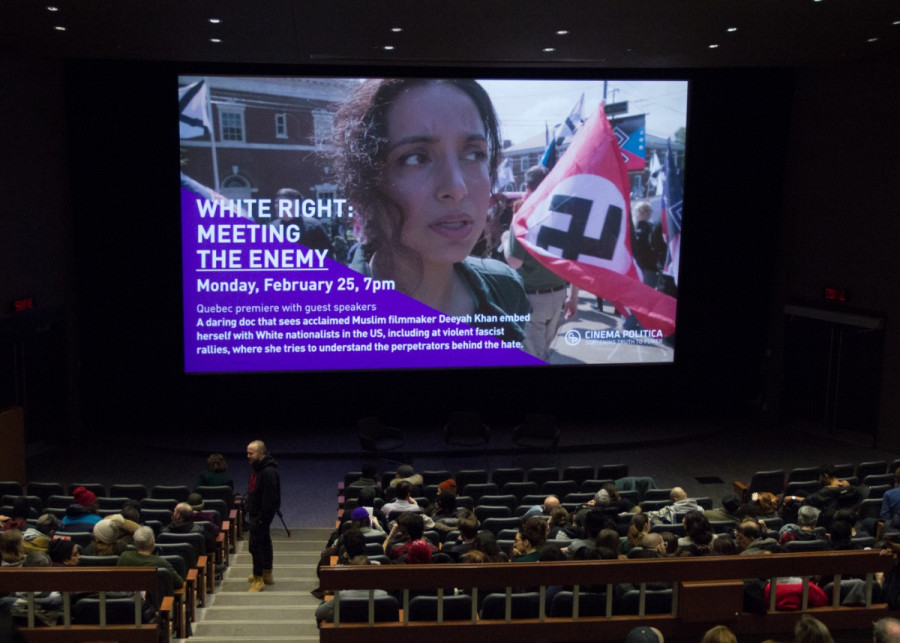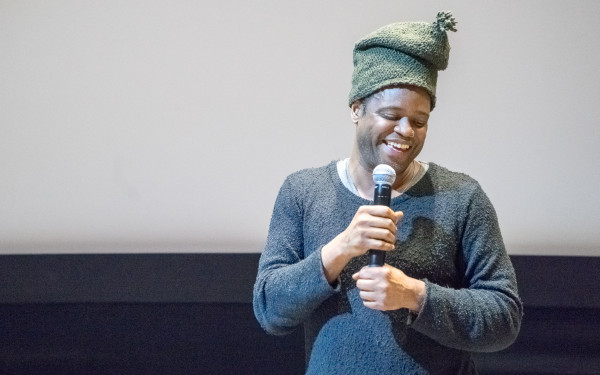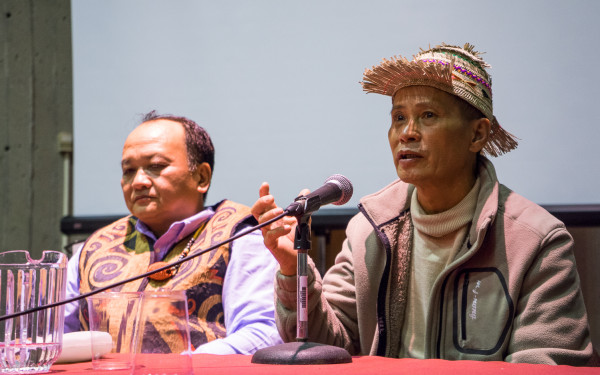Film Review: ‘White Right: Meeting the Enemy’ Investigates What Leads Many to Extremism
Documentary Gets Eerily Personal with Members of the Alt-Right
The Emmy award-winning documentary White Right: Meeting the Enemy, directed by Deeyah Khan, had its Quebec release at Cinema Politica at Concordia’s downtown theatre on Feb. 25.
By 7 p.m. the theatre was packed with students and community members. Before the film began, anti-racist activist Aaron Lakoff, a co-presenter of the documentary, shared some words about nationalism in Canada and Quebec. He stressed that while Canadians may believe they aren’t impacted by extremism, we need only remind ourselves of the Quebec City mosque shooting of 2017. The election of the CAQ, he warned, is “putting wind in the sails” of far-right extremists here in Quebec.
White Right: Meeting the Enemy is built around interviews Khan conducted with white nationalists, neo-nazis, and other American hate groups. Khan, a Muslim woman, did it with the drive to better understand the resurgence of white extremism in the United States.
White nationalism has been rearing its ugly head around the world in recent years. With this new frightening reality, journalists, filmmakers, and the like have the difficult task of telling stories about extremism without bolstering, spreading, and platforming these ideologies of hate. White Right, could have damaged its own cause if Khan wasn’t thoughtful in her approach.
Thankfully, White Right was a skillfully made film that gripped the audience with the realities of racialized hate, examining how extremism becomes normalized to those involved.
The film opened with a head-on shot of Jared Taylor, prominent figure of the modern white nationalist movement. From all accounts, Taylor could be any white man you see walking down the street. He was an clean-cut middle aged man in a well-tailored suit, asking if his hair is okay for the camera. He speaks with the air of a someone who is confident and highly educated.
Yet, this veil of “normalcy” quickly disappears when, from behind the camera, Khan asks if she, as a Muslim, immigrant, and “lefty liberal” was his enemy. Taylor’s response is the film’s thesis. He replies, “You’re not subjectively my enemy, but what you are promoting will lead to the disappearance of my people and my culture.”
White Right uncovers a complicated cognitive dissonance within extremists. They begin to respect Khan as an individual, often calling her a friend, yet continue to loathe and fear the demographic groups she represents.
_900_600_90.jpg)
One of the most impactful parts of the film comes when Khan speaks to Brian Culpepper from the National Socialist Movement.
As a white nationalist, Culpepper advocates ridding the United States of non-white peoples to create an ethnostate just for whites. She asks him if to complete his idealized white nation he would deport her. He responds that Khan has become his friend and he has great respect for her. While he wouldn’t want to deport her, he would have to for his vision to be executed.
In another striking series of scenes, Khan visits Charlottesville, Virginia, for the infamous August 12, 2017 “Unite the Right” rally. At the event, a neo-nazi killed anti-fascist protestor Heather Heyer by ramming into the protesters with a vehicle. The attack also injured dozens of other counter-protestors, and started the national conversation about white extremism.
In Charlottesville, Khan tagged along with a group of neo-nazis behind the Nationalist Socialist Movement to get a behind-the-scenes look of the rally.
As the men were loading up their trucks with banners and shields before the rally, Khan noticed how they deliberately removed swastikas from their signs. Why? Their PR representative explained they needed to promote a “softer image” of the movement so they could attract a younger audience.
This scene is emblematic of why the alt-right and other far-right groups are so insidious. Gone (or less visible) are the skinheads with swastikas or Klan robes. They now cloak themselves as moderates so they can trick and recruit impressionable young people.
The footage of the riots at Charlottesville that was shown was hard to watch. We see moments of violence between fascist and anti-fascist forces, with police seemingly nowhere in sight, juxtaposed with alt-right men screaming slurs at counter-protesters.
Particularly haunting is an interview Khan conducts with an African-American man leaning on the police barricade at the frontlines of the protest, oblivious to the ensuing tragedy. “There may be a glimmer of hope,” he asserts. “I don’t know where it is, but it will come.” As his city falls into disarray, hours before the killing of Heather Heyer, this man still proclaims a faith in humanity.
Khan also interviewed a number of ex-skinheads to discuss what leads someone to extremism. In two cases, the men she talks to reveal they came from hard upbringings and turned to hate groups for acceptance and refuge.
These interviews were not forgiving, but were understanding. These men showed that racism is taught and learned, and can ultimately be unlearned through will and determination.
The panel discussion that followed the film featured Marilou Craft, an artist and activist who led the protests against the controversial play SLȂV, and Touhami Rachid Raffa, the former president of the Islamic Cultural Centre of Quebec (the location of Quebec’s 2017 mosque shooting).
Craft emphasized that no one interviewed in the film considered themselves to be “racist.” They all believed they were simply defending themselves and their race. No one today self-identifies as racist.
Rachid Raffa was especially moved by Khan’s interviews of ex-skinheads. He commented, “this film is remarkable for me for one reason: there is hope.”
White Right: Meeting the Enemy is a disturbing film. We see into the eyes of white supremacists, yet throughout the film Khan finds humanity even in the most deplorable.
White Right is not, however, apologetic about white nationalists. Rather, Khan’s film shows that even the most monstrous people our society has produced are still people, and they can be de-radicalized.
The intention of the film is clear: the audience is not meant to sympathize with the neo-nazis, nor to relate to them. White Right asks us, instead, to explore the idea that these people can be changed.


_600_832_s.png)




